
The Falklands War was a ten-week undeclared war between Argentina and the United Kingdom in 1982 over two British dependent territories in the South Atlantic: the Falkland Islands and its territorial dependency, South Georgia and the South Sandwich Islands. The conflict began on 2 April 1982, when Argentina invaded and occupied the Falkland Islands, followed by the invasion of South Georgia the next day. On 5 April, the British government dispatched a naval task force to engage the Argentine Navy and Air Force before making an amphibious assault on the islands. The conflict lasted 74 days and ended with an Argentine surrender on 14 June, returning the islands to British control. In total, 649 Argentine military personnel, 255 British military personnel, and three Falkland Islanders were killed during the hostilities.

The Fleet Air Arm (FAA) is the naval aviation component of the United Kingdom's Royal Navy (RN). The FAA is one of five RN fighting arms. As of 2023 it is a primarily helicopter force, undertaking roles once performed by biplanes such as the Fairey Swordfish. It operates the F-35 Lightning II for maritime strike and the AW159 Wildcat and AW101 Merlin for commando and anti-submarine warfare.
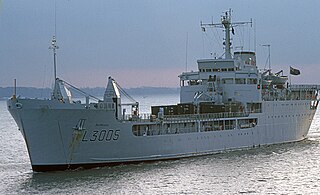
RFA Sir Galahad (L3005) was a Round Table-class landing ship logistics vessel belonging to the Royal Fleet Auxiliary (RFA) of the United Kingdom. The ship saw service in the Falklands War of 1982, where she was bombed and set afire at Fitzroy on 8 June.
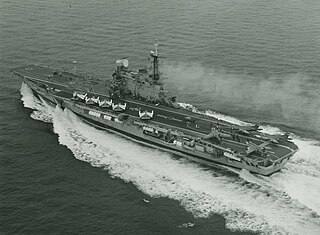
HMS Hermes was a conventional British aircraft carrier and the last of the Centaur class.

HMS Invincible was the Royal Navy's lead ship of her class of three light aircraft carriers. She was launched on 3 May 1977 as the seventh ship to carry the name. She was originally designated as an anti-submarine warfare carrier, but was used as an aircraft carrier during the Falklands War, when she was deployed with HMS Hermes. She took over as flagship of the British fleet when Hermes was sold to India. Invincible was also deployed in the Yugoslav Wars and the Iraq War. In 2005, she was decommissioned, and was eventually sold for scrap in February 2011.

This is a list of aviation-related events from 1982.

HMS Splendid was a Royal Navy nuclear-powered fleet submarine of the Swiftsure class. From commissioning in 1979 to her decommission in 2004 she took part in many operations involving British forces around the globe.
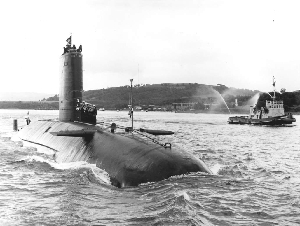
HMS Conqueror was a British Churchill-class nuclear-powered fleet submarine which served in the Royal Navy from 1971 to 1990. She was the third submarine of her class, following the earlier Churchill and Courageous, all designed to face the Soviet threat at sea. She was built by Cammell Laird at Birkenhead.

HMS Illustrious was a light aircraft carrier of the Royal Navy and the second of three Invincible-class ships constructed in the late 1970s and early 1980s. She was the fifth warship and second aircraft carrier to bear the name Illustrious, and was affectionately known to her crew as "Lusty". In 1982, the conflict in the Falklands necessitated that Illustrious be completed and rushed south to join her sister ship HMS Invincible and the veteran carrier HMS Hermes. To this end, she was brought forward by three months for completion at Swan Hunter Shipyard, then commissioned on 20 June 1982 at sea en route to Portsmouth Dockyard to take on board extra stores and crew. She arrived in the Falklands to relieve Invincible on 28 August 1982 in a steam past. Returning to the United Kingdom, she was not formally commissioned into the fleet until 20 March 1983. After her South Atlantic deployment, she was deployed on Operation Southern Watch in Iraq, then Operation Deny Flight in Bosnia during the 1990s and Operation Palliser in Sierra Leone in 2000. An extensive re-fit during 2002 prevented her from involvement in the 2003 Iraq War, but she was returned to service in time to assist British citizens trapped by the 2006 Lebanon War.

HMS Antelope was a Type 21 frigate of the Royal Navy that participated in the Falklands War and was sunk by Argentine aircraft.

ARA Veinticinco de Mayo (V-2) was an aircraft carrier in the Argentine Navy from 1969 to 1997. The English translation of the name is Twenty-fifth of May, which is the date of Argentina's May Revolution in 1810.

USS Iwo Jima (LPH-2) was the lead ship of her class and type and the first amphibious assault ship to be designed and built from the keel up as a dedicated helicopter carrier. She carried helicopters and typically embarked USMC elements of a Marine Amphibious Unit (MAU)/later Marine Expeditionary Unit (MEU) principally the Aviation Combat Element (ACE) to conduct heliborne operations in support of an amphibious operation. There was no well deck to support landing craft movement of personnel or equipment to/from shore. Iwo Jima was the second of three ships of the United States Navy to be named for the Battle of Iwo Jima, although the first to be completed and see service.

Standing Royal Navy deployments is a list of operations and commitments undertaken by the United Kingdom's Royal Navy on a worldwide basis. The following list details these commitments and deployments sorted by region and in alphabetical order. Routine deployments made by the Navy's nuclear-powered submarines and their location of operations is classified.
A group is a military unit or a military formation that is most often associated with military aviation.

The Multinational Force in Lebanon (MNF) was an international peacekeeping force created in August 1982 following a 1981 U.S.-brokered ceasefire between the Palestine Liberation Organization (PLO) and Israel to end their involvement in the conflict between Lebanon's pro-government and pro-Syrian factions. The ceasefire held until June 3, 1982 when the Abu Nidal Organization attempted to assassinate Shlomo Argov, Israel's ambassador to London. Israel blamed the PLO and three days later invaded Lebanon. West Beirut was besieged for seven weeks before the PLO acceded to a new agreement for their withdrawal. The agreement provided for the deployment of a Multinational Force to assist the Lebanese Armed Forces in evacuating the PLO, Syrian forces and other foreign combatants involved in Lebanon's civil war.
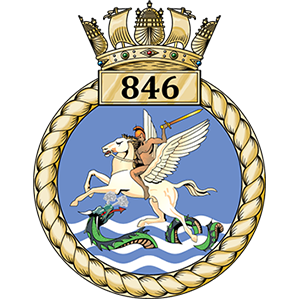
846 Naval Air Squadron is a squadron of the Royal Navy's Fleet Air Arm.

Carrier Air Wing Eight (CVW-8), is a United States Navy aircraft carrier air wing based at Naval Air Station Oceana, Virginia. The air wing is attached to the aircraft carrier USS Gerald R. Ford (CVN-78)
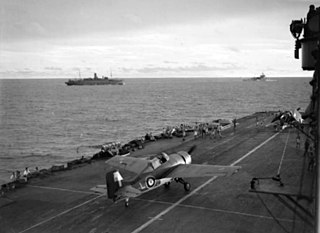
Aircraft carriers are warships that evolved from balloon-carrying wooden vessels into nuclear-powered vessels carrying many dozens of fixed- and rotary-wing aircraft. Since their introduction they have allowed naval forces to project air power great distances without having to depend on local bases for staging aircraft operations.

Attack Squadron 75 (VA-75) or ATKRON 75 was an attack squadron of the United States Navy that was active from World War II through the 1990s. Nicknamed the "Sunday Punchers," they were based out of Naval Air Station Oceana, Virginia. Originally established as Bombing Squadron EIGHTEEN (VB-18) on 20 July 1943, it was redesignated Attack Squadron VA-7A on 15 November 1946, redesignated Attack Squadron VA-74 on 27 July 1948, redesignated Attack Squadron VA-75 on 15 February 1950 and disestablished on 28 February 1997. They were the second squadron to be designated VA-75, the first VA-75 was disestablished on 30 November 1949. They were the first fleet squadron to operate the A-6 Intruder and the last unit to fly it in operational service.
899 Naval Air Squadron was a squadron of the Fleet Air Arm of the United Kingdom.


















